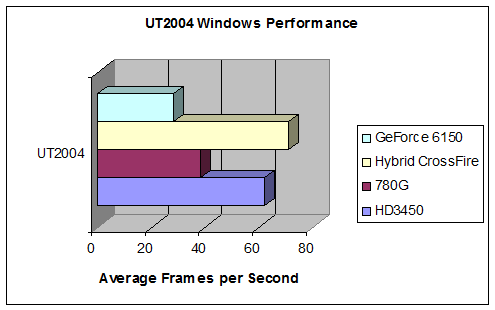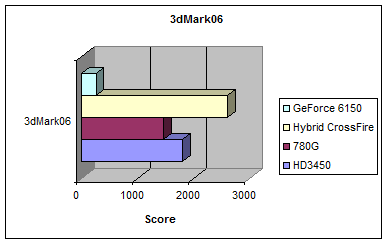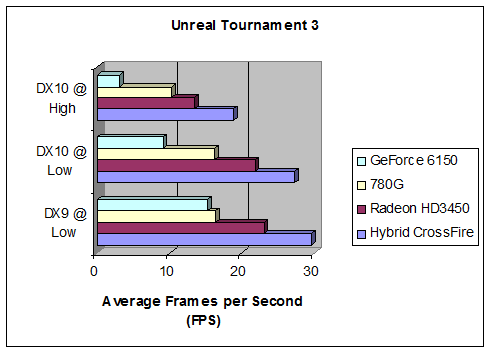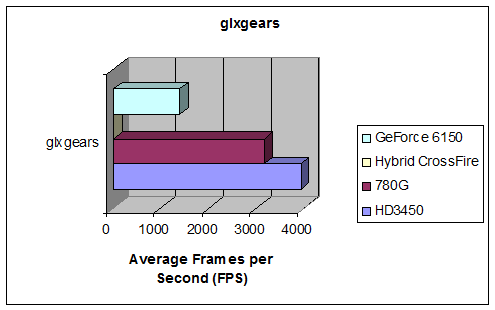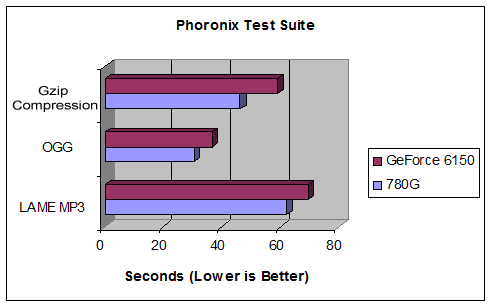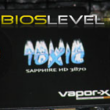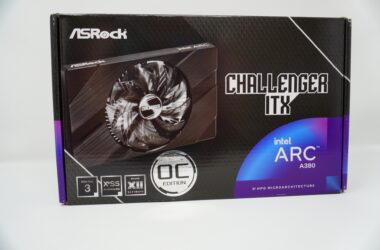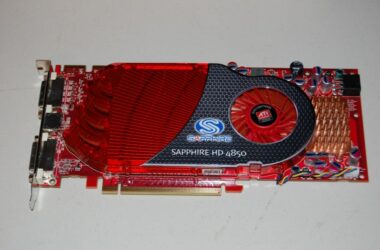Introduction
Typically, I try to avoid integrated chipsets. Integrated chipsets are usually meant for mainstream use and don’t feature gaming-class graphics options. Fortunately, ATI recently introduced the new 780G chipset with more than just a beefier integrated graphics solution: Hybrid Crossfire.
Sapphire sent us its PURE-series PI-AM2RS780G motherboard featuring the 780G chipset. This chipset is capable of handling 125W Phenom processors—something of which other 780G motherboards are incapable. On-board is a Radeon HD3200 integrated graphics solution, which may not seem overly powerful on its own, but Hybrid Crossfire promises to raise the bar.
Appearance & Features
The PI-AM2RS780G’s packaging in a black-and-green box, bearing AMD’s ever-familiar colors, and logo. Sharing space with AMD’s logo is Sapphires’, and Sapphire’s “PURE” brand logo resides on the bottom of the box’s front side.
The rear of the box shares the color scheme, and lists several of the board’s top-features such as the chipset, DDR2 RAM support, Hybrid Graphics, High Definition supports, and RAID functionality. To the right of the features is an overall product description:
Escaping the limitations of traditional mainboards, the Sapphire PURE CrossFire line has long been declared the frame-rate leader for gaming platforms, as well as the clear choice for enthusiasts, and the Sapphire PURE Hybrid CrossFire 780G tightens the family’s grip on the reputation as the industries innovative answer to the performance vs. stability debate. Built upon AMD’s eagerly anticipated 780G chipset, the Sapphire PURE Hybrid CrossFire technology provides video upgrades for integrated motherboard PC users.
Along with the 780G chipset, the PI-AM2RS780G also features the SB700 southbridge, which controls audio, hard drives, PCI-Express, and USB. Below are the selling features of the board:
| Chipset: | AMD® 780G + SB700 | Processor: | Support AMD® AM2/AM2+ CPU | DirectX ® 10 Gaming | ATI Hybrid CrossFire HD3200 Graphics | Full HD Experience | Ultimate Green PC | HT3.0 support | DDRII DIMM up to 8GB 800MHz Dual Channel | Internal Video output: | DVI-D(HDMI) + VGA |
Amongst these features are a single PCI-Express 2.0 x16 slot running at full speed, and two PCI slots. It’s somewhat a disappointment Sapphire didn’t include a PCI-Express x1 slot for additional expansion such as a TV Tuner.
The board supports up to 8 GB of RAM and six SATA2 hard drives, making sure some seriously storage and memory power. Not many mATX motherboards feature four RAM slots.
Hybrid CrossFire is AMD’s newest creation. It works by allowing users to run two similar graphics cards in a CrossFire configuration. The cards need not be the same model, but similar in terms of specifications. For this review, the motherboard’s integrated graphics chipset will run alongside a low-end discrete graphics card in a CrossFire configuration. It promises a 40-70% jump in performance in many of today’s games, but we’re curious what kind of jump that be when the discrete card in question is the Radeon HD3450, also provided by Sapphire. Impressive as it may seem, but the RS780 graphics core is merely a Radeon HD2400 integrated with the motherboard. Now that’s some real power.
The Radeon HD3450 is a PCI-Express 2.0 discrete graphics card, and features a passive cooling heatsink, meaning the card is dead silent. It supports DirectX 10, as well as ATI’s unified video decoder, which takes the load of the CPU while watching HD movies. Aside from Hybrid CrossFire, the card itself supports CrossFireX, allowing for scaling up to four GPUs. Today, however, we’ll only be looking at Hybrid CrossFire.
Installation
Installation was trivial for the PI-AM2RS780G. I was able to snap the I/O shield in to our case, the Thermaltake M9. Following that, I installed the motherboard, Phenom 9500 provided by AMD, and OCZ’s 2GB kit of DDR2 PC2-8500 Reaper HPC CrossFire Certified Edition RAM.
I also tried to install a CPU Cooler from CoolJag, but the PI-AM2RS780G north bridge was much too close to the heatsink clips.
I’ll be using both Windows and Linux. Let’s look at the final system specifications before I move in to the benchmarks. Also note that I’ve opted to test this system against a similarly-equipped ECS GeForce 6150 motherboard.
| Processor | AMD Phenom 9500 | AMD Athlon64 X2 5000+ |
| Motherboard | Sapphire PI-AM2RS780G 780G | ECS GeForce 6150/nForce 430 |
| RAM | 2GB DDR2 PC2-8500 Reaper HPC CrossFire Certified | 2GB DDR2 PC2-8500 WinTel |
| Video Card | RS780 / Radeon HD3450 / CrossFire | Integrated GeForce 6150 |
| Chassis | Thermaltake M9 | |
| CPU Cooling | Xigmatek HDT-S1283 | |
| Hard Drive | Excelstor 250GB SATA2 | |
| Power Supply | StarTech.com WattSmart 750W Power Supply | |
| Display | 1280×1024 | |
Despite being powered by a slower processor, we still feel any benchmarks will still give good indication of any advantages or (particularly) disadvantages the 780G board has.
Windows Benchmarks
Much like our previous review of Sapphire’s Radeon HD3870 Toxic, we’ve selected a variety of games and benchmarks to benchmark the motherboard in both graphical and overall performance. These tests will include Unreal Tournament 2004, Unreal Tournament 3, 3dMark06, PCMark Vantage, and the SiSoft Sandra suite. I’ve opted to omit 3dMark Vantage, as the onboard graphics were incapable of running it. Let’s look at Sandra benchmarks first.
Sandra
Sandra offers various benchmarks for looking at the performance of a system. For this system, I chose to look at processor arithmetic, cache and memory performance, memory bandwidth, and multi-core efficiency.
All of these tests focused on the processor more than the motherboard, but the motherboard is still an essential part of a system’s performance. Sandra provides several example systems to compare our results again. Unfortunately, they all seem to be faster than our current system.
PCMark Vantage
PCMark Vantage is Futuremark’s latest release of the PCMark series, sharing the new “Vantage” brand much like the latest 3dMark release. PCMark Vantage aims to benchmark every aspect of PC usage, from gaming, to office productivity, to multimedia creation and viewing. Unlike 3dMark Vantage and 3dMark 06, however, Futuremark released a 64-bit version of PCMark Vantage, finally giving us a native 64-bit benchmark.
The graph above shows that the Sapphire 780G motherboard scored a whopping 500 points higher than the GeForce 6150 motherboard. For a newer benchmark that brings current hardware to it’s knees, this is a significant difference.
Windows Benchmarks, Continued
Unreal Tournament 2004
Unreal Tournament 2004 (UT2004) is one of the few commercial games with a native Linux port, making it ideal for benchmarking purposes. My testing in Windows involves all the graphical goodies turned to the maximum and a resolution of 1280×1024. As with our other reviews utilizing UT2004 as a benchmark, I used to following command-line options to benchmark: ut2004 dm-rankin?spectatoronly=1?numbots=12?quickstart=1?attractcam=1 -benchmark -seconds=77 -ini=default.ini
As I expected, GeForce 6150 falls short of matching the PI-AM2RS780G’s graphical power. The HD2400 is several generations newer than the GeForce 6150, and the integrated GeForce 6150 was much weaker than it’s discrete counter-part.
3dMark06
Futuremark has yet to release a 64-bit edition of any gaming benchmarks, so I was expecting to see low numbers using this setup in a 64-bit environment. Unfortunately, neither the GeForce 6150 or 780G motherboards were able to run 3dMark Vantage, so I’ve settled for only showing results for 3dMark06. 3dMark06 was run with default settings with all tests selected.
Hybrid CrossFire definitely came through here, beating the HD3450 on its own by 800 points. The GeForce 6150 came in at a mere 832 points, falling well behind the 780G’s score. For multimedia or older gaming use, the PI-AM2RS780G’s integrated graphics seem to hold their own. 3dMark shows Hybrid CrossFire as a 43% improvement over the HD3450, and a whopping 80% improvement over the 780G’s onboard graphics. This is impressive.
Unreal Tournament 3
Epic’s latest installment of the Unreal Tournament series is based on the Unreal 3 engine, the same engine that powers games such as Gears of War, BioShock, and Stargate Worlds. When installed under Vista, Unreal Tournament 3 is able to utilize DirectX 10 for improved graphics and lighting. Like any graphical improvement however, there is a hit on performance, as the graphs below will show.
To benchmark Unreal Tournament 3, I opted to benchmark with varied settings to show the performance differed between the level of detail, as well as DirectX 9 versus DirectX 10. To benchmark UT3, I used ut3bench, which allows me to define my graphical settings and features.
While none of the numbers are particularly promising, Hybrid CrossFire makes the game playable at an average of 29.59 FPS. Unfortunately, it only achieves this framerate in DirectX 9 mode, so I was left out in terms of DirectX 10 eye candy.
Conclusion on Windows Benchmarks
The 780G chipset powering Sapphire’s PI-AM2RS780G motherboard blows nVidia’s GeForce 6150/nForce 430 chipset out of the water in Windows benchmarks. Although the GeForce 6150 is a few generations behind the 780G, it remains one of the popular chipsets for home theater PCs, as well as cheap Linux systems because of it’s Linux shupport.
Although the 780G came out the winner in Windows benchmarks, I wanted to guess that the GeForce 6150 would have a slight advantage in Linux judging by our previous reviews of nVidia and ATI products.
Linux Benchmarks
Similar to previous reviews, I wanted to look at glxgears, Unreal Tournament 2004, and several benchmarks featured in Phoronix’s test suite. Again, I’ve opted to compare them to the same GeForce 6150/nForce 430 system I used in the previous benchmarks.
I initially expected to see the GeForce 6150 stay competitive with Sapphire’s offerings due to driver issues in Linux, but the benchmarks coming up proved my expectations wrong.
Unfortunately, we won’t be able to benchmark the HD3450 and 780G’s integrated graphics in Hybrid CrossFire, as AMD has yet to bring CrossFire to Linux. It’s a shame, because Hybrid CrossFire particularly would be a great benefit to not only open source gaming, but also the 3D desktop.
Unreal Tournament 2004
As I mentioned in the Windows portion of this review, Unreal Tournament 2004 is one of the few modern commercial games with a native Linux port. Other games falling in this category are DOOM 3, Quake 4, and Enemy Territory: Quake Wars, which all are based on DOOM 3’s engine. On with the benchmarks.
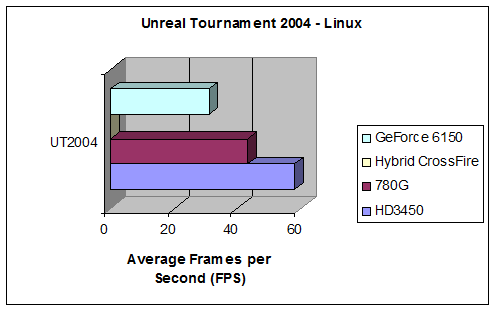
The 780G’s integrated graphics beat the GeForce 6150 by an average of 10FPS, whereas the Radeon HD3450 cranks the performance up to 58FPS. Between the 780G’s 31FPS and the HD3450’s 58FPS, the game would be perfectly playable under either platform.
glxgears
glxgears won’t necessarily say whether or not one card is better than another, as features between cards differ. However, when there’s a large gap in performance under such a simple benchmark, one may wonder if this holds true. I don’t.
<
The 780G’s onboard graphics more than double the GeForce 6150’s performance, while the HD3450 nearly triples it. Much like in UT2004, AMD’s offerings have beaten nVidia’s.
Linux Benchmarks: Phoronix Test Suite
Phoronix’s test suite is a new member of the benchmark block, but my-oh-my is it powerful. It includes some of the most common Linux benchmarks, particularly the ones used by Phoronix in their own reviews.
I’ve selected their motherboard suite benchmarks, which include audio compression, hard drive performance, and gzip compression. Also included is a few program compilation benchmarks, but I’ve chosen to omit these results as they are heavily influenced by the processors, or at least more so than the audio compression.
The PI-AM2RS780G holds roughly a 20-30% advantage over the GeForce 6150/nForce 430 board. Some of this may be accounted for by the faster processor, but certainly not all of it.
Hard Drive Performance?
Every so often, my base install of Ubuntu 8.04 feels slightly sluggish. After running some of the Phoronix benchmarks, I understood why: the hard drive was only being read at a mere 1.83MB/sec, whereas it was being read at an average of 67MB/sec in Windows.
My first inclination was to change the SATA controller’s mode in the BIOS, but this proved fruitless: the results were the same. After some investigation online, I found that some of the patches meant for the new SB700 southbridge may not have made it in to the kernel just yet. As kernel 2.6.25 is not yet in Ubuntu’s repository at the time of this writing, I decided to stick with the 2.6.24 kernel for the above benchmarks. Despite the lag in hard drive speed, the board still put the heat on the GeForce 6150.
Final Thoughts & Conclusion
Unlike some the results I saw in our review of the Radeon HD3870 Toxic, Sapphire’s AMD offering is the clearcut winner between motherboards in this review. In Windows, we saw a slight performance gap between the 780G’s onboard graphics compared to the 6150’s offering, but when I compared the HD3450 and Hybrid CrossFire against the GeForce 6150, that gap only lengthened, putting AMD on top.
I saw a 40% to 80% increase in performance while the 780G’s onboard graphics were in CrossFire mode with the Radeon HD3450, with Hybrid Crossfire nearly doubling the onboard graphic’s 3dMark06 score.
In Linux, where I expected to see the GeForec 6150 / nForce 430 motherboard regain some ground, I was surprised to see the performance gap between the products remain the same. Although Hybrid Crossfire isn’t available to Linux users, the HD3450 and 780G kept a 20% to 30% lead on the GeForce 6150.
Since Sapphire’s PI-AM2RS780G and Radeon HD3450 are both HDCP compliant, there should be no issues using a DVD-D to HDMI adapter to connect these graphics solutions to an HDTV for some high definition gaming or movie watching.
The only downsides I found with the board was the poor Linux support for the SATA controller, and the fact that the system locks up when trying to run 3dMark Vantage with the 780G’s onboard graphics. Otherwise, Sapphire’s PI-AM2RS780G has proved to be a powerful and ultimately stable base for any AMD-based system. With support for Hybrid CrossFire, consumers are free to buy this motherboard and upgrade their 3D performance at a later time with the purchase of a Radeon HD3450 or similar card.
Pros
- PCI-Express 2.0 Support
- Onboard video is fast for onboard video
- 6 SATA II ports
- Dual Monitor Support
- Hybrid CrossFire with Radeon 3450 and similar cards for improved performance
- Support for 125W Phenom CPUs
- HDCP / HDMI compliant for watching HD movies on HD displays
Cons
- Linux support for SATA controller isn’t exactly great
- Northbridge is in the way of installing some CPU coolers
























